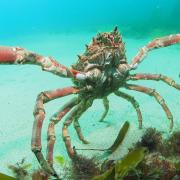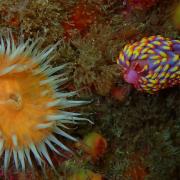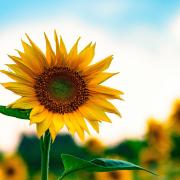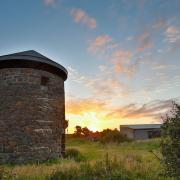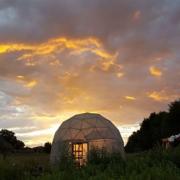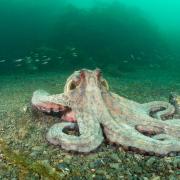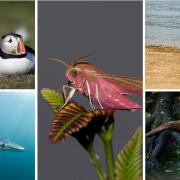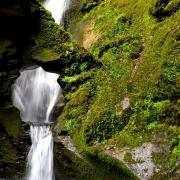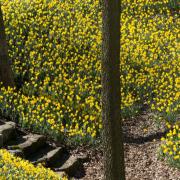Love them or hate them, starlings are definately hard to ignore. David Chapman argues the case for the bird with a big personality.

A cheeky garden visitor; a bold bird taking rubbish from dustbins at holiday resorts and motorway service stations; a bird forming huge flocks at dusk; a mimic of a variety of other birds’ calls as well as telephones, car alarms and whistles; a pest of orchards; the starling means something different to all of us but one thing is for sure, it is a bird full of character and interest.

I am an admirer of starlings, they seem to have adapted well to the presence of humans on a large scale. They nest in our houses, sing from our aerials, take scraps from our gardens and often roost in our town centres. Despite this apparent tolerance and contrary to the opinions of many people they are not fairing well having lost more than 70 per cent of their population in recent years putting them ‘on the critical list of UK birds most at risk’ according to the Royal Society for the Protection of Birds (RSPB). In fact the number of starlings reported from gardens around the UK has fallen by nearly 80 per cent in the last 30-odd years.
Around 60 per cent of their diet comes from invertebrates found in grassy pastures and it might be that their decline is due to a corresponding decline in this prey. The loss of permanent pasture, possibly in other parts of Europe, as well as the use of chemicals in farming are believed to be having a huge impact on the starling population.
Starlings have long had an association with people and particularly farming. When starlings alight on the backs of sheep they are taking ticks and other parasites from the sheep’s skin. This behaviour has led to many localised names for the starling including ‘sheep stare’. The name ‘stare’ and ultimately ‘starling’ may have derived from the greek word ‘psaros’ meaning flecked or it may have the same derivation as the word ‘star’. Either way it is most likely that the name is due to the white speckled plumage of the birds.
Starlings can easily be watched at many Cornish locations, I favour St Ives where they come and take bits of pasty on the sea front and show off their beautiful plumage whilst sitting on the wires and buildings singing their hearts out. Many other Cornish towns are good for seeing starlings but farmland around Bodmin Moor holds the largest concentration in Cornwall during the autumn and winter.
The starling moults in late summer and it is then that its plumage has the fine white spots, in the shape of arrowheads, on the tips of its feathers. During the winter the tips of the feathers wear away leaving the bird largely black but with its characteristic iridescent sheen. The colours in the feathers vary from purple to green depending upon the angle of light.
In August starlings begin to gather in post breeding flocks in which they feed and roost. The many juvenile starlings seen at this time of year are grey-brown and completely lack the spots of the adult birds until they moult during late summer/early autumn. During the autumn the number of starlings in Cornwall is boosted by immigrants from Scandinavia and Eastern Europe seeking the mild conditions.From late October through the winter each evening just before dusk starlings gather at roost sites, they will fly up to about 20 miles to get to the roost. Sometimes many thousands of birds form huge flocks in the sky these clouds of birds twist and turn in a ripple effect as if acting as one entity, a phenomenon known as a murmuration. To avoid mid-air collisions individual birds must watch the changes in direction of others at least two ahead of them making instantaneous decisions and following their lead almost to the wing beat. It is thought by scientists that these wheeling masses of birds are intended to deter predators by confusing them. Sparrowhawks often sit nearby watching the starlings gathering, they take their chance by flying at speed into the flock hoping to pick one of them off.
I have my own theory about why the flocks of starlings twist and turn so much. I reckon each bird needs to go to the toilet before going to bed and in order to do this it must get to the bottom of the flock. So they each take it in turns to pay a visit. The scientistshaven’t thought of this particular explanation just yet but it’s only a matter of time. Anyway, should you find yourself underneath a flock of a million starlings I would advise you not to look up!
Their roost sites can occur in woods, urban areas or reedbeds, but there are occasions when even the most popular roost sites can be deserted. The single biggest and most reliable roost of starlings in Cornwall is in the pine trees near Rough Tor car park on Bodmin Moor. Arrive at this car park at sunset to see often well over a million birds flying to the roost.
Marazion Marsh traditionally hosts a large roost and after a few disappointing years last autumn there was again a good number of birds here. This roost is occupied only for the first half of the winter. Other possible sites include Par Beach Pool, Hayle Estuary and Loe Pool. All these roosts tend to be better if the weather is very cold and most hold birds from late October.










